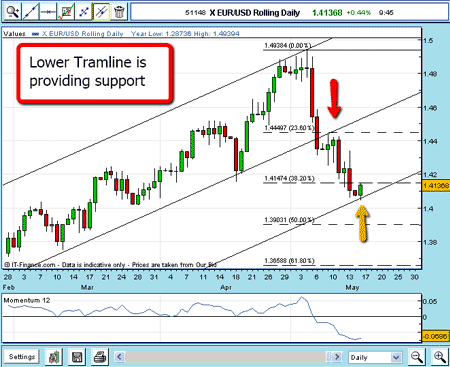Is the dollar due a massive rally?
The US dollar has been without friends for some time now. But could it be due a big rally? John C Burford looks at the charts to see what they can tell him about where the greenback might go from here.
For some time, it has been clear to me that the bullish case for commodities has been primarily a dollar story (see my recent silver post).
Just take a look at the movements in the US dollar index, which represents a basket of currencies, with the euro by far the largest component.
Could we see a shock dollar rally?

(Click on the chart for a larger version)
MoneyWeek
Subscribe to MoneyWeek today and get your first six magazine issues absolutely FREE

Sign up to Money Morning
Don't miss the latest investment and personal finances news, market analysis, plus money-saving tips with our free twice-daily newsletter
Don't miss the latest investment and personal finances news, market analysis, plus money-saving tips with our free twice-daily newsletter
The dollar has had some wild swings in recent months. From the 70 low in the summer of 2008, it rallied to 90 in early 2009 (a gain of 28%), and then fell back to 73 (a loss of 19%).
It then rallied to 89 in the summer of 2010 (a gain of 22%), and has recently fallen to 72 ( a loss of 19%).
And currently, it has few friends. You will have to search pretty hard to find recent bullish articles on the greenback. The nightmare scenarios of waves of quantitative easing money-printing and consequent hyper-inflation are all over the blogosphere and the mainstream media.
But is all this negative comment setting the stage for a dollar rally?
Big turning points are almost always made when market sentiment is very one-sided.
However, market sentiment measures are blunt instruments! You cannot use them for timing the markets without other input.
Now the dollar has retreated to the low 70s, will that level hold (again)?
The tramlines joining the tops and bottoms appear solid - and the latest low has hit the lower tramline - just when bullish sentiment is at a record low.
The dollar is currently bouncing off the lower tramline.
And what about the euro?
Now let's look at the euro, which is the most practical trading vehicle for spread betting.

(Click on the chart for a larger version)
This daily chart shows a textbook Elliott three-wave rally pattern (with a long wave C) and the very solid tramlines. Note the upper tramline sports several exact touch-points, as does the centre one.
When the centre tramline was breached on 6 May, I then drew my lower tramline equidistant and parallel.
Here is a close-up:

(Click on the chart for a larger version)
Notice the pull-back after breaking the central tramline to the underside of the tramline (red arrow) - and then a 'scalded cat bounce' away.
I have marked today's lowest tramline bounce by a yellow arrow.
But when the central tramline broke on 6 May, I was able to predict the likely target for the euro my lowest tramline!
This line was drawn equidistant and parallel to the two original tramlines on 6 May. This line was hit today, 16 May.
But that is not all. I can also draw another separate tramline set on the hourly chart:

(Click on the chart for a larger version)
I have shown a close-up, but if you go to your own charting package, you will find several touch-points from previous trading.
So now I have two targets arrived at by two tramline sets both at the same price!
That point of support should be formidable.
So, the long-term picture is bullish for the dollar, but the short-term is bearish. In other words, a pretty normal trading situation!
Trading the markets always involves having to use incomplete and often contradictory information.
And that includes chart as well as fundamental information. You have to go with the balance of probabilities, as you see it.
But that is what makes a market a basic disagreement over the outlook for prices.
To me, if a decent euro rally does not develop from here, that may well be a signal for more selling. Meanwhile,the dollar index will catch another bid, driving the huge army of dollar bears out of the market.
NB: Don't miss my next trading insight. To receive all my spread betting blog posts by email, as soon as I've written them, just sign up here .
Get the latest financial news, insights and expert analysis from our award-winning MoneyWeek team, to help you understand what really matters when it comes to your finances.
John is is a British-born lapsed PhD physicist, who previously worked for Nasa on the Mars exploration team. He is a former commodity trading advisor with the US Commodities Futures Trading Commission, and worked in a boutique futures house in California in the 1980s.
He was a partner in one of the first futures newsletter advisory services, based in Washington DC, specialising in pork bellies and currencies. John is primarily a chart-reading trader, having cut his trading teeth in the days before PCs.
As well as his work in the financial world, he has launched, run and sold several 'real' businesses producing 'real' products.
-
 NS&I cuts interest rates on 8 savings accounts
NS&I cuts interest rates on 8 savings accountsNS&I will now offer less attractive interest rates for customers wishing to lock their savings away to grow for one, two, three or five years.
-
 Investors will reap long-term rewards from UK equities
Investors will reap long-term rewards from UK equitiesOpinion Nick Train, portfolio manager, Finsbury Growth & Income Trust, highlights three UK equities where he’d put his money